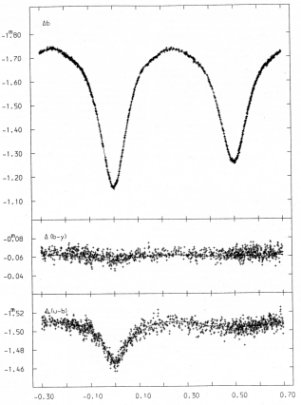
 |
Every 1.4545 days, each of the two blue class B stars of V Puppis partially eclipses the other, as seen in the top plot made in blue light. The left-hand eclipse is that of the larger, hotter, more luminous star by the smaller, while the right-hand one is that of the smaller by the larger. Neither star can completely hide the other. Moreover, the distortion of the two caused by tides and rotation renders the binary continuously variable even when there is no actual eclipse going on, as we see different projections of the distorted surfaces as the stars go around each other. The middle plot shows only slight variations in the amount of blue light relative to yellow (visual) light, while the bottom one shows ultraviolet-to-blue color changes. The bigger dip at bottom is the result of the eclipse of the hotter star. The stars are so close together that the smaller and fainter of the two loses mass to the larger. (From an article by J. Andersen, J. V. Clausen, A. Gimenez, and B. Nordstrom in Astronomy and Astrophysics, vol. 128, p. 17, 1983.) |